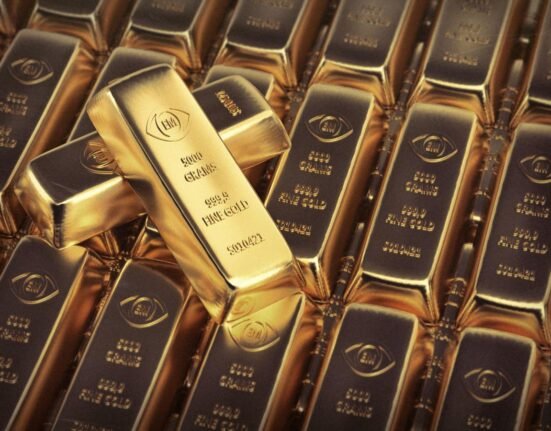- Gold price attracts buyers for the third straight day amid the global flight to safety.
- Rising geopolitical risks and trade uncertainties boost traditional safe-haven assets.
- Fed rate cut bets also benefit the XAU/USD pair, though rebounding USD caps gains.
Gold price (XAU/USD) continues scaling higher for the third consecutive day on Friday, rising to the $3,444 area, or its highest level since April 22 during the Asian session amid the global flight to safety. The global risk sentiment takes a turn for the worse in reaction to escalating geopolitical tensions in the Middle East. Furthermore, persistent trade-related uncertainties weigh on investors’ sentiment, which, in turn, is seen as a key factor underpinning demand for the traditional safe-haven bullion.
Meanwhile, the US Producer Price Index (PPI) released on Thursday pointed to further signs of cooling inflation and reaffirmed bets that the Federal Reserve (Fed) would lower borrowing costs further in 2025. This drives additional flows towards the non-yielding Gold price and contributes to the positive momentum. Bulls seem unaffected by a modest US Dollar (USD) bounce from its lowest level since March 2022, suggesting that the path of least resistance for the XAU/USD pair remains to the upside.
Daily Digest Market Movers: Gold price benefits from safe-haven buying amid rising Middle East tensions
- Israel launched pre-emptive airstrikes against Iran on Friday, targeting its nuclear plant and military sites. This marks a dramatic escalation of the long-running regional conflict in the Middle East and lifts the safe-haven Gold price to its highest level since April 22 during the Asian session.
- Israel’s Prime Minister Benjamin Netanyahu said that the operation targeted Iran’s nuclear program and will continue for as many days as it takes to remove this threat. Israel declared a state of emergency, saying that retaliatory action from Iran was possible following the operation.
- Meanwhile, a spokesperson for Iran’s armed forces said that Israel carried out the attacks with support from the US. However, top US diplomat Marco Rubio said that America was not involved in the strikes and that Israel had told them that this action was necessary for its self-defense.
- Iran’s Supreme Leader, Ayatollah Ali Khamenei, said that with this attack, Israel has prepared a bitter fate for itself and vowed severe punishment for what he called a crime. This raises the risk of a region-wide and more devastating war, weighing on investors’ sentiment.
- On the trade-related front, US President Donald Trump expanded the 50% steel tariffs to a range of household appliances. US Commerce Secretary Howard Lutnick said that tariff levels on Chinese imports remain at 55% and would not change from this point onward.
- The US Bureau of Labour Statistics reported that the Producer Price Index remained muted in May and rose 0.1% compared to a revised 0.2% decline in April. This comes on top of a marginal rise in US consumer prices, backing the case for further easing by the Federal Reserve.
- Traders now look to the Preliminary release of the Michigan US Consumer Sentiment Index and Inflation Expectations for a short-term impetus. The focus, however, will remain glued to developments surrounding Trump’s trade policies and conflicts in the Middle East.
Gold price seems poised to appreciate further towards testing the all-time peak, around the $3,500 mark

From a technical perspective, the recent move higher witnessed over the past month or so has been along an upward-sloping channel. This points to a well-established short-term uptrend, which, along with the fact that oscillators on the daily chart are holding in bullish territory, validates the near-term positive outlook for the Gold price. Hence, a subsequent move towards challenging the all-time peak, around the $3,500 psychological mark touched in April, looks like a distinct possibility. The said handle coincides with the top boundary of the ascending channel, which if cleared decisively will be seen as a fresh trigger for bullish traders.
On the flip side, any corrective pullback might now be seen as a buying opportunity and find decent support near the $3,400 mark. Some follow-through selling below the $3,385 region, however, should pave the way for additional losses towards the $3,355 intermediate support en route to the $3,330-3,329 region, representing the lower end of the ascending channel. A convincing break below the latter would negate the constructive setup and shift the near-term bias in favor of bearish traders.
Gold FAQs
Gold has played a key role in human’s history as it has been widely used as a store of value and medium of exchange. Currently, apart from its shine and usage for jewelry, the precious metal is widely seen as a safe-haven asset, meaning that it is considered a good investment during turbulent times. Gold is also widely seen as a hedge against inflation and against depreciating currencies as it doesn’t rely on any specific issuer or government.
Central banks are the biggest Gold holders. In their aim to support their currencies in turbulent times, central banks tend to diversify their reserves and buy Gold to improve the perceived strength of the economy and the currency. High Gold reserves can be a source of trust for a country’s solvency. Central banks added 1,136 tonnes of Gold worth around $70 billion to their reserves in 2022, according to data from the World Gold Council. This is the highest yearly purchase since records began. Central banks from emerging economies such as China, India and Turkey are quickly increasing their Gold reserves.
Gold has an inverse correlation with the US Dollar and US Treasuries, which are both major reserve and safe-haven assets. When the Dollar depreciates, Gold tends to rise, enabling investors and central banks to diversify their assets in turbulent times. Gold is also inversely correlated with risk assets. A rally in the stock market tends to weaken Gold price, while sell-offs in riskier markets tend to favor the precious metal.
The price can move due to a wide range of factors. Geopolitical instability or fears of a deep recession can quickly make Gold price escalate due to its safe-haven status. As a yield-less asset, Gold tends to rise with lower interest rates, while higher cost of money usually weighs down on the yellow metal. Still, most moves depend on how the US Dollar (USD) behaves as the asset is priced in dollars (XAU/USD). A strong Dollar tends to keep the price of Gold controlled, whereas a weaker Dollar is likely to push Gold prices up.







